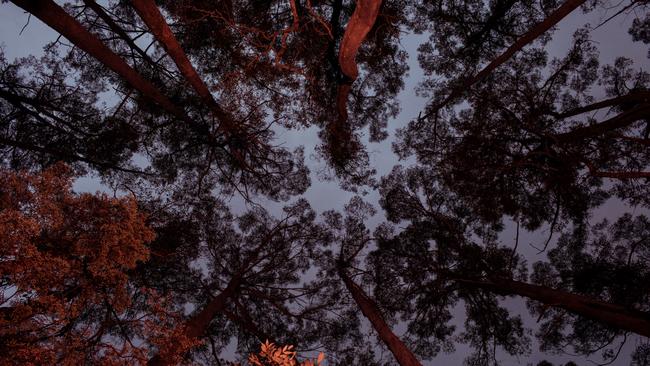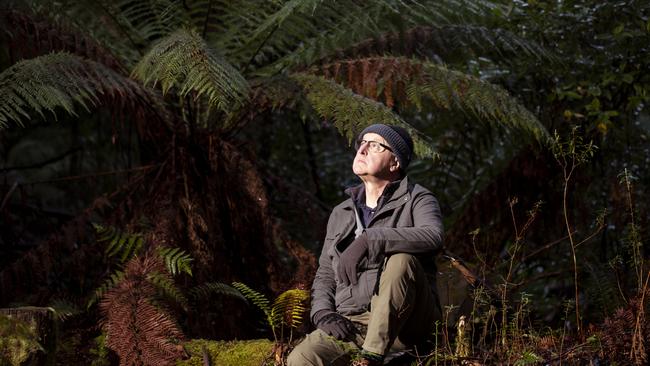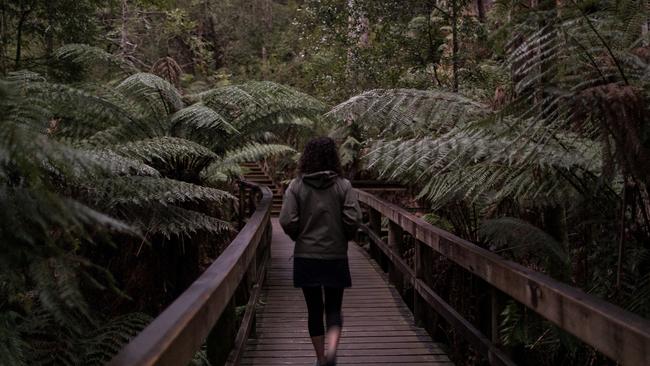TasWeekend: Project X in Tasmania’s far South helping bring visitors back to Huon after bushfires
It’s innovative, edgy, and a little eerie — no less than you would expect when you let DarkLab loose in a Far South forest. Two thousand talking ravens? But of course. A bizarre but welcome tourism blessing after the bushfire? Absolutely.
Lifestyle
Don't miss out on the headlines from Lifestyle. Followed categories will be added to My News.
LOCAL communities rally after bushfires and, once upon a time in Tasmania, you can bet your fluffiest sponge cake it would have been a stalwart group such as the Country Women’s Association that mounted a recovery art event in a stricken region.
Grassroots groups, aided by the Mercury’s Get Back to the Huon campaign, were typically quick to respond after the Riveaux Road fire devoured 31,500ha and decimated tourism in the state’s Far South in January, but in this case they were joined by the black-winged magicians of DarkLab.
The edgy event offshoot of Mona swept in promising an art activation to bring visitors back to the region.
Led by creative director Leigh Carmichael, DarkLab is the same notoriously nocturnal team that transformed winter nights in Hobart in 2013 when it launched the annual Dark Mofo art, food and music festival.
Like its Mona mother, DarkLab has serious form when it comes to crowd-pulling, It also has serious form in its financing. The entire project is supported by $2 million over one year — $1.5 million in Federal funding and $500,000 from the State Government. But this regional project presented an additional challenge in its isolation. The location is called the Far South for a reason. Can the mysteriously named Project X do for the remote locale what Dark Mofo does for Hobart’s darkest nights?

I’m down at Hastings Caves to find out, having driven two hours south from the capital on a damp Saturday afternoon.
All rugged up and raincoated, I am about to experience the first installation of Project X, a twilight acoustic piece featuring the sounds of 2000 ravens roosting.
Called Hrafn: Conversations with Odin, the work made its deep-forest Tasmanian debut over Dark Mofo in June. After a short hibernation, it is back on, running three nights a week until late October.
The 40-minute piece was recorded by soundman extraordinaire Chris Watson over a week on the Welsh island of Anglesey about five years ago.
After he arranged it into a single soundtrack, it was installed in a forest park in England’s Northumberland, where it drew thousands of visitors to hear the liminal “talk” of one of the world’s most clever birds as it settled en masse for the night.
“Ravens are probably the most intelligent of all birds,” Watson told me during his visit to Tasmania to install Hrafn before the winter festival.
“They can solve problems and they have very complex vocabularies — and possibly even a language — so people have understood them to be super-smart birds. But I think that’s why there’s also fear of them as well, particularly when they’re in numbers.”
As he made his initial recordings, Watson started noticing very particular communicative contact calls. Convinced the ravens were exchanging important information, perhaps on flight routes and the availability of food resources, he was reminded of the myth of Norse god Odin, who was believed to have had two ravens on call — one called Huginn (thought), the other Muninn (memory) — for long-flight reconnaissance missions.
“Odin sent the pair out every day as his eyes and ears and they flew all over the world, including over the forests of Tasmania, and came back to the hall of Valhalla in the evening, perching on Odin’s shoulders at dinnertime to tell him everything they had seen and heard.
“The idea that people in ancient times were close to ravens and [perhaps understood] their conversation fascinated me,” Watson said.

I confessed to having mixed feelings about black corvids, feeling dread when I heard the cawing of crows because when I was a child they would peck out the eyes of our lambing ewes in strife and their newborns.
“It’s interesting you mention the eyes of newborn lambs,” he said, noting that the black bird is more often considered sacred than evil across world cultures and history.
“When ravens would come down onto the battlefield after the Vikings, the eyes of fallen warriors were the first they they’d go for. The way the Vikings saw it, the ravens were literally taking the spirits of Vikings up to Valhalla.”
The light is falling when our group of about 20 meets at the carpark of the Hastings Caves Visitors Centre. Aboard a bus into the forest beyond, we’re as excited as a bunch of school kids getting out of maths to go on an outing.
Spilling out at the mouth of a gloomy pathway, we break into two groups, each with a local guide to regale us with raven lore while ensuring we don’t get lost.
One of the guides tonight is Helen Whitty, who belongs to grassroots community alliance Far South Future. The evening’s other guide is Rose, who runs a beautiful circa 1876 guest house at nearby Southport called The Jetty House.
Into the forest — or woods, as Watson would say — we go. We’re not far from Newdegate Cave, the largest tourist cave in the country, but we are sticking on terra firma in the Hastings Cave State Reserve rather than heading underground.
Still, the rainforest with its towering canopy feels tunnel-like as we go deeper in among ferns, moss, sassafras and tea trees. Along the way, the guides share the myth of Odin, god of war, death and much else. It emerges that the Hrafn of the title is Old Norse for raven.
Then our guides fall silent and ask us to do the same. Deep in the forest, we drop down from the duckboard and scramble over logs until we reach a circle of stumps in a small clearing.
Taking my stump, I can barely make out the faces of the others in the circle. As we cower in light rain, we hear the sounds of the first birds coming in from afar. As their numbers build, so does the density of sound, which is more like cooing and clucking and altogether more soothing than the dreaded cawing.

As I gaze at the soaring treetops, scanning for birds and camouflaged speakers in the sooty darkness, I feel a bit disconcerted. Briefly, I transpose the veracity of sights and sounds, thinking my canopy view is a film and the sounds I hear are coming from ravens that are really here (it’s such a Mona moment, I know).
A few blinks later, I return to reality and listen quietly to more than half an hour of these seldom-heard avian sounds. Every time I peek over at my artist friend Catherine, she is sitting stock still, seemingly transfixed.
I have three children with me, too, and though one gets a leg cramp in the cold, I can see they are rapt by this oddly constructed night-time in nature.
Even the youngest one, aged 7, barely wriggles in my arms as the crescendo drops off and the ravens finally settle for the long night. When she leads all 20 of us out of the forest by torchlight, I say that maybe she is Muninn, the memory raven, retracing our steps so we don’t get lost.
How long has it been since we spent an hour in a winter forest at night, I wonder. These bird noises are unlike anything I’ve heard before in such a sequence, but it is the total experience that makes it so special.
Hrafn is a subtle work, as befits a master of his trade. Chris Watson is not your average sound mixer. International galleries and festivals including The National Gallery in London, The Louvre in Paris and the Aichi Triennial in Japan have commissioned installations by the Englishman, whose speciality is location sounds, with a particular interest in the sounds of wildlife habitats around the world.
He has recorded and featured in many BBC Radio 4 and World Service productions, and his TV work includes many credits in the David Attenborough Life series, including The Life of Birds, a BAFTA Award winner for best factual sound in 1996, and BBC series Frozen Planet, which won the same award in 2012.
Watson made Hrafn in a collaboration with The Wired Lab, an artist-led initiative directed by Sarah Last that produces site-based contemporary art in regional areas of Australia. The pair has worked together on various projects over a decade. Both are intensely interested in the local response to projects.
“It’s not your typical art-going audience that engages,” Last, who spent days setting up in the forest before Dark Mofo, told me. “You get a really broad demographic, and I think Hrafn is going to get a really wonderful representation of age groups.”

What would the locals make of it, though, I asked. Based on past experience, they would embrace its presence, she said. “Locals tend to really enjoy the attention and insights such projects bring. Something like Hrafn gives the people living there a new valuing of who they are and where they live.”
Sounds a bit like the so-called Mona Effect to me. Last said she was careful, though, not to pitch such projects as “art” to the locals.
“We are more likely to present it as ‘just coming along to an event’,” she said.
As a marketing campaign of Project X and the Far South, supported by Tourism Tasmania, rolls out in coming weeks, everyone is hopeful that visitation to the Far South will grow, boosting the tourism economy so blighted by last summer’s bushfires. A lot of effort is going into the promotion, with a bunch of leading arts journalists from interstate visiting in coming weeks.
Before moving to Tasmania, our guide Helen Whitty used to run the public programs at Sydney’s Powerhouse Museum of Applied Arts and Sciences. She knows the power of art as a geographical drawcard, but she says she’s not sure everybody appreciates just what a coup the Hrafn installation is for the Far South, where she lives.
“There has been some criticism that they are not local ravens or artists,” Whitty tells me later. “I say it’s a miracle to get a work like this. You don’t look at a Van Gogh of sunflowers and say it should be grevillea. There are greater levels to it than literal.
“Hrafn is a fine piece and it’s a gift to us, providing the opportunity for employment for the tourist operators who lost business during and after the fires. Attention is starting to be paid to the Far South as a destination. We are now on the map.”
Hrafn: Conversations with Odin is on Thursday-Saturday until October 26. Starting before dusk (times vary over season). $25 for Tasmanians, $45 for others. Under 15s are free. Book at project-x.net.au
TasWeekend’s visit to Hrafn: Conversations with Odin was hosted by DarkLab and Essentially Tas accommodation, which offers a range of unique holiday properties in the Far South, including Rock Lobster, a modern four-bedroom house on the waterfront at Southport (15 minutes from Hastings Caves), with wood heater and outdoor jacuzzi.
For more information and bookings, visit essentiallytas.com


